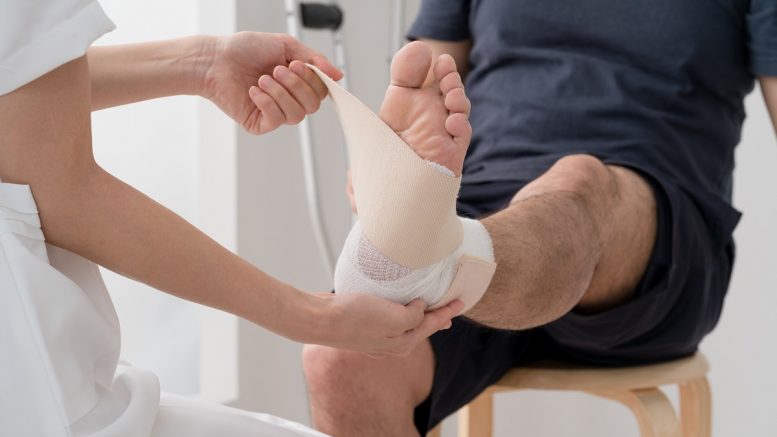Around 3.8 million people in the UK alone suffer from wounds according to research from 2017-18. [1] Following the lockdowns and closure of healthcare services during COVID, which left many patients to self-manage wound care without regular support from healthcare professionals, this number is likely to be higher now. This is not helped by the nature of some wounds which can be very hard to heal, with some patients suffering with their wounds for decades with little or no signs of healing.
Leg ulcers are among the most common form of chronic wound. Venous leg ulcers (VLUs) in particular are the most prevalent type of leg ulcer, making up approximately 80 percent of all cases[2]. VLUs are chronic skin ulcers that affect the gaiter area. They are caused by damaged or blocked veins in the leg either due to trauma, deep vein thrombosis, varicose veins, or oedema, limiting and preventing backflow of blood to the heart. This triggers a build-up of blood in the lower leg causing oedema and ulceration.[3]
Burdening patients and healthcare systems
Wounds such as VLUs disproportionately impact older generations, so as the population ages, so does the burden of caring for wound patients. On a macro level the cost to the NHS annually is a staggering £8.3 billion of which £5.6 billion is management of wounds that fail to heal.1 VLUs represent more than £2 billion of this annual cost and affect one in 500 people.2
Behind these figures, however, are tens of thousands of personal tragedies: wound patients living in discomfort and constant pain; people unable to work thanks to their wounds; individuals having to lead less active lives due to the burden of the condition; feelings of shame and embarrassment. This leads to further complications including obesity, depression, or wound infections. The latter is a serious issue in itself; an infected wound may itch, puss and release an unpleasant smell, which can cause further distress, discomfort and embarrassment for patients.[4] If left untreated, infected wounds can lead to septicaemia (blood poisoning) and sometimes limb amputation.[5]
A growing need for ongoing care
Treatment of wounds is labour intensive and complicated. It relies on a mixture of visits to hospitals or clinics or home visits from nurses, adding to the complexity in the delivery of wound care. VLU patients will be prescribed compression therapy as standard of care to increase microcirculatory blood flow. This typically involves medically prescribed compression bandaging or stockings. Compression therapy reduces vein distension activating the calf muscle pump to push blood back to the heart and reduce oedema.[6]
Compression therapy comes in various forms, including four-layer, two-layer, hosiery kits and wraps, depending on the level of compression required for optimal VLU healing, as well as the patient’s preferences. However, for many, compression treatment can be extremely uncomfortable, impacting their ability to adequately adhere – and for some, due to the nature of their pain, they are unable to initially be prescribed compression therapy at all, receiving only light bandaging.
Despite the different compression treatments available, healing can be slow. Only 53 percent of VLUs heal within one year[7] and some never heal at all. Recurrence rates are estimated at 57 percent by one year[8] leaving many patients suffering with VLUs on an ongoing basis. Adherence to VLU treatment has significant impacts on healing. If treated appropriately, VLUs can heal in four months3 as opposed to years or not at all. Early intervention can also avoid recurrences: early endovenous ablation – a procedure to close off varicose veins – is reported to accelerate VLU healing and reduce recurrences. [9]
However, the current state of play in wound care reports that adherence to treatment is low – estimated to be between 12-52 percent.[10] There have also been few improvements over the last 30 years in the adherence to VLU treatment.[11]
Innovation driving life changing solutions
For healthcare systems to be able to manage the burden of an ageing population effectively, they need new solutions to age old problems like wound care. Fortunately, innovations in medical technology (MedTech) are enhancing the delivery of treatment in all areas of healthcare. MedTech has the capability to transform how common but debilitating conditions are addressed, helping drive a healthier and more productive population.
In the case of wound care, a recent randomised self-controlled trial (RCT)[12] has been shown to double the rate of healing in VLU patients, versus standard of care alone, through the deployment of a MedTech device: the geko™ device. The geko™ is a watch sized device worn at the knee that sends electrical pulses through the lower leg to speed the flow of blood. The RCT has demonstrated that patients using the geko™ device, in combination with multi-layer compression, accelerated the rate of VLU healing by more than double.
The impact is transformational: the accelerated rate of healing of hard-to-heal VLUs is addressed, people need treatment for a shorter time, and faster healing wounds – in theory – reduce the opportunity for infection. Combined, this means nurses and wound clinics can care for more people over a shorter period and – best of all – patients spend less time immobile, uncomfortable and unwell – which is better for their physical and mental health. This has the added benefit of contributing to saved healthcare costs.
Investing in a healthier future
With the number of people not working due to sickness at a record high of 2.5 million[13], more innovation in addressing complex but non-life-threatening medical issues needs to be adopted to help drive additional economic productivity and to ensure that healthcare systems can address medical issues in meaningful and cost-effective ways.
Thanks to the time and dedication of clinical champions, more innovation is being adopted into healthcare systems that transforms patient outcomes for the better and enhances healthcare delivery, usually with cost-saving benefits. The geko™ device is a great example of how successful innovation can take place.
By Bernard Ross, CEO of Sky Medical Technology
References
[1] Guest, J.F., Fuller, G.W., Vowden, P. 2020. Cohort study evaluating the burden of wounds to the UK’s National Health Service in 2017/2018: update from 2012/2013. BMJ Open 2020;10:e045253. doi:10.1136/ bmjopen-2020-045253. Available at: https://bmjopen.bmj.com/content/10/12/e045253
[2] National Health Service. (2019) Overview: venous leg ulcers. Available at: https://www.nhs.uk/conditions/leg-ulcer/
[3] https://www.woundsinternational.com/uploads/resources/content_10445.pdf
[4] National Health Service. (2019) Symptoms of venous leg ulcers. Available at: https://www.nhs.uk/conditions/leg-ulcer/symptoms/.
[5] InformedHealth.org [Internet]. Cologne, Germany: Institute for Quality and Efficiency in Health Care (IQWiG); 2006-. Chronic wounds: Overview. 2006 Oct 17 [Updated 2018 Jun 14]. Available at: https://www.ncbi.nlm.nih.gov/books/NBK326431/
[6] Brem H, Kirsner RS, Falanga V. Protocol for the successful treatment of venous ulcers. Am J Surg. 2004;188(Suppl 1A):1–8. doi:10.1016/ S0002-9610(03)00284-8
[7] Guest JF, Fuller GW, Vowden P. Venous leg ulcer management in clinical practice in the UK: costs and outcomes. Int Wound J 2018;15:29–37 https://doi.org/doi:10.1111/iwj.12814pmid:http://www.ncbi.nlm.nih.gov/pubmed/29243398
[8] Finlayson K, Wu M-L, Edwards HE. Identifying risk factors and protective factors for venous leg ulcer recurrence using a theoretical approach: a longitudinal study. Int J Nurs Stud 2015;52:1042–51 https://doi.org/doi:10.1016/j.ijnurstu.2015.02.016pmid:http://www.ncbi.nlm.nih.gov/pubmed/25801312
[9] Gohel MS, Mora, MSc J, Szigeti M, et al. Long-term Clinical and Cost-effectiveness of Early Endovenous Ablation in Venous Ulceration: A Randomized Clinical Trial. JAMA Surg. 2020;155(12):1113–1121. doi:10.1001/jamasurg.2020.3845
[10] Finlayson K, Edwards H, Courtney M. The impact of psychosocial factors on adherence to compression therapy to prevent recurrence of venous leg ulcers. J Clin Nurs. 2010;19(9–10):1289–1297. doi:10.1111/j.1365-2702.2009.03151.x [PubMed] [CrossRef] [Google Scholar]
[11] Harding K, Dowsett C, Fias L et al (2015) Simplifying Venous Leg Ulcer Management. Consensus Recommendations. Available at: http://www.woundsinternational.com/consensus-documents/view/simplifyingvenous-leg-ulcer-management
[12] Bull, RH, Clements, D, Collarte, AJ, Harding, KG. The impact of a new intervention for venous leg ulcers: A within-patient controlled trial. Int Wound J. 2023; 1- 9. doi:10.1111/iwj.14107
[13] Office for National Statistics (ONS), released 10 November 2022, ONS website, article, Half a million more people are out of the labour force because of long-term sickness





